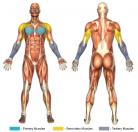Push-Up (Flat Surface)
Performance Description
- Lie face down (prone) with palms placed at side of the chest, hands about shoulder-width apart (shoulder width is the classic position), and feet slightly apart or side by side. The body should be straight (not concave or convex) and eyes should be fixed forward toward the horizon.
- From the lowered starting position, press the body upward until the arms are completely extended, exhaling throughout the motion.
- Lower the body downward until the rib cage is near to the ground, inhaling throughout the motion.
- Repeat steps 2-3.
Primary Muscle(s)
Chest (Pectoralis Major)
Chest (Pectoralis Major: Clavicular 'Upper' Head)
Secondary Muscle(s)
Shoulders (Deltoid: Anterior)
Triceps (Triceps Brachii: Lateral Head)
Triceps (Triceps Brachii: Long Head)
Triceps (Triceps Brachii: Medial Head)
Tertiary Muscle(s)
Forearms (Anconeus)
Further Clarification
If the elbows are pointing backward, the triceps will be more involved; if the elbows are pointing outward toward the sides, the pectorals will be more involved.
There are several push-up variations, each of which will change the focus to different parts of the pectorals.
A tilt of the body, and hence the chest, changes the focus in the following ways:
- Place the feet higher than the upper body to isolate the clavicular head of the pectorals (the upper chest).
- With the upper body higher than the feet the inferior part of the pectorals are isolated.
Differing the distance that the hands are from one another changes the focus in the following ways:
- Widening the hands isolates the lateral part of the pectorals (the outer chest).
- Placing the hands nearly side by side, under the body, isolates the sternal head of the pectorals (the inner chest). This is often called the 'diamond' position because the fore finger of each hand and the thumb of each hand will meet to form a diamond shape).
Level
Beginner
Exercise Variations
Considered An Exercise In The Following Categories





